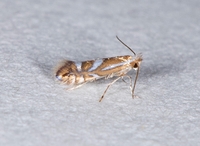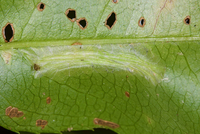Identification
Field Guide Descriptions: Beadle and Leckie (2012) Online Resources: MPG , BugGuide , iNaturalist , Google , BAMONA , GBIF , BOLD , iNat Search Technical Description, Adults: Braun, 1908.Technical Description, Immature Stages: Eiseman, 2019.
Adult Markings: The following description is primarily based on Braun's (1908) original description of the species. The antenna is dark gray, and the face and palps are silvery. The tuft is dark brown with a mix of whitish scales. The ground color of the thorax and forewing of the male is brownish golden (more golden in the female), with darker scales near the middle of the wing and in the dorsal half. The dorsal margin is narrowly white towards the base. The thorax has a white line across the anterior margin that passes over the patagia and is continuous with the white basal streak on the forewing. The basal streak is rather broad and pointed at the apex, and ends at about two-fifths of the wing length. It is black margined on the costal side and around its apex. The forewing has four costal and three dorsal white streaks. The first costal is just before the middle, is very oblique, and is dark margined on both sides. The other three costal streaks are nearly perpendicular to the costa and are dark margined on the anterior side only. The first dorsal streak begins much nearer the base than the first costal streak and is dark margined on both sides. It is long and oblique, with its apex reaching to or beyond that of the first costal streak (sometimes almost to the space between the second costal and dorsal streaks). The second dorsal streak is nearly perpendicular to the dorsal margin and opposite the second costal streak. The remaining dorsal and costal streaks are greatly reduced in size and often inconspicuous. A concentration of blackish brown scales between the second pair of streaks extends backward along the middle of the wing to the apex where it may form a dark streak, and is better developed in the male. The marginal line in the cilia is blackish, with a bluish metallic luster. The cilia are grayish ocherous and less gray in the female. The hindwings and cilia are grayish, with a fulvous tinge. The legs are ocherous with gray banding on the tarsi. Phyllonorycter propinquinella is very similar to P. blancardella and P. crataegella and is best identified either by rearing the adults or by using genitalia or molecular markers. Braun (1908) noted that P. propinquinella differs from P. crataegella in being larger (wingspan 8-9 mm versus 6.5-7 mm for P. crataegella ), and in having a more oblique first dorsal streak that is nearer the base of the wing relative to that of P. crataegella . Phyllonorycter blancardella is a specialist on apples and crabapples and is a more northern form that has not been found in North Carolina as of 2022.
Wingspan: 8-9 mm (Braun, 1908).
Adult ID Requirements: Identifiable from good quality photos of unworn specimens.
Immatures and Development: The larvae form underside tentiform mines that are typically 1-1.5 cm in length. An initial linear portion is sometimes evident that expands into the tentiform blotch. As larvae feed they deposit the frass in a central dark mass (Eiseman, 2019). Mines that we examined in North Carolina had several longitudinal folds, were often slightly bowed, and were usually placed roughly parallel to the midrib or along the leaf margin. When viewed from the upper leaf surface, the tentiform mines were speckled with small green and whitish blotches that tended to turn brown with age. Individual leaves normally contained a single mine, but occasionally had two, and the mines were common on seedlings. This species uses Black Cherry and the mines closely resemble those of certain Parornix species that mine Black Cherry. It is important to rear the adults to obtain a positive identification.

 »
»




 »
»


